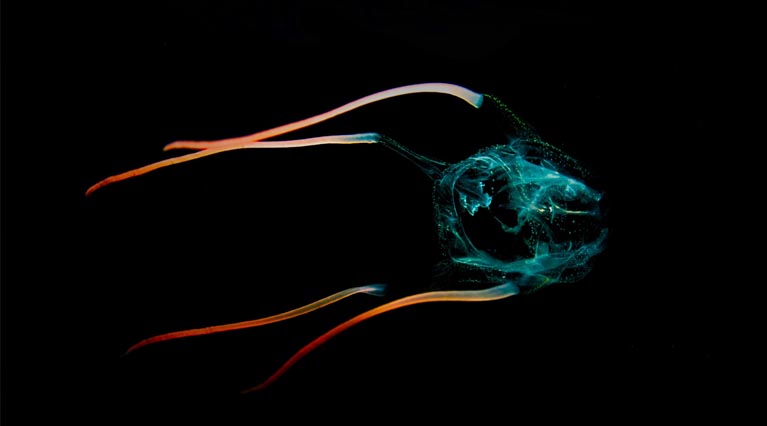Last modified on August 3rd, 2020 at 5:47 am
Box Jellyfish: Why Are They So Deadly?
There are many creatures on earth that are considered deadly to humans, from snakes, to lions, tigers and bears, oh my! Arguably the most deadly is other humans. Coming in a close second are microbes, creatures we can’t even see but cause most deadly diseases.
We know all this, but what many people don’t know, is that the worlds most venomous marine animal thrives in habitats occupied by humans, is incredibly hard to spot, and has enough venom to kill multiple adults. Nearly 100 people die each year from injuries caused by the box jellyfish.
When determining how deadly a venomous a creature is, you generally want to take two metrics into consideration:
1. How many people an ounce of venom can kill
2. The length of time it will take for the person to die after being bitten, or in this case stung.
When looking at both metrics, the box jellyfish or ‘sea wasp’, named for its body shape, takes the cake. Coming in at an average weight of 4.4 lbs, just a single box Jellyfish has the ability to kill 60 adults.
Box Jellyfish Anatomy
There are notable physical differences between box jellyfish and other jellyfish. Rather than the usual dome shape we see with most classes of jellyfish, the sea wasp is shaped more like a boxy umbrella. Their design helps them move much more effectively than any other types of jellyfish.
From each of their 4 lower corners hangs a short stalk, which bears one or more hollow tentacles. Similar to other jellyfish, the tentacles are what you need to worry about.
Some species of box jellyfish have tentacles that are 10 feet long, while others, like the species irukandji, are small enough to fit on a quarter. The Irukandji are the smallest, most venomous box jellyfish in the world.
Additionally, the box jellyfish has a nervous system that is much more sophisticated than other jellyfish. This species has a nerve base that allows it to coordinate movements, and can reach speeds of up to 4.6mph (4 knots, 7.4 km/h).
Box Jellyfish are one of the few classes of jellyfish that have eyes, 24 of them to be exact. They are able to distinguish between light and dark, and make it possible for them to find their prey.
Where Do Box Jellyfish Live?
Box Jellyfish can be found in just about any warm coastal region. Various species can be found in areas of tropic, or sub tropic oceans including the Atlantic to East Pacific, with some species reaching as far north as California. Traditionally, Box Jellyfish are most common to the following regions:
Australia
The most lethal varieties are found near the region of North Australia. This includes the largest, and most deadly Australian Box Jellyfish (Chironex Fleckeri). This particular species has tentacles that can be up to 10 feet long, and are mostly translucent. You will find the jellyfish in this region almost year-round, with particularly large influxes during mating season.
Hawaii
According to Hawaii Magazine, “at least 3 species of box jellyfish…are known to live in Hawaii’s waters. And, on O‘ahu’s south-facing beaches, inshore numbers of these translucent invertebrates pulse monthly as they head into shallower waters to spawn.” Although you won’t find box jellies in Hawaii consistently, they have been swarming the shores during a particular window each month since 1988.
Florida
Traditionally box jellyfish are not native to the water surrounding Florida, but during the last week of July 2016, a potentially deadly species of box jellyfish washed ashore in Cocoa Beach, Florida.
Without a physical sample, The Florida Fish and Wildlife Commission cannot be 100% sure that the jellyfish spotted and photographed above is a box jellyfish, but all visual signals point there. FWC has noted that its staff has found species of box jellyfish washed ashore in Brevard County before, so it would not be out of the question to have one be seen again.
Sting symptoms and treatment
Once a box jellyfish stings you, you’ll know it it. Symptoms of a sting include excruciating pain, itching, rashes, and welts. If left untreated, you will begin to experience nausea, diarrhea, swelling lymph nodes, muscle spasms, coma, and sometimes death.
Once a tentacle of the it attaches itself, it then pumps nematocysts with venom into the skin. This is what causes the sting and agonizing pain. Pouring vinegar onto the sting area will deactivate the nematocysts that have not attached, and prevent further stings.
Once this has been done, the tentacles should be removed with a glove or towel. This should be done with extreme caution, removing the tentacles could cause unfired nematocysts to fire and cause more stinging.
Do not pour sea water, fresh water, or urine on the sting area. These at best will do nothing. Pouring any liquid other than vinegar on the stings can actually spread the cells around, causing more nematocysts to fire.
If symptoms continue to worsen, the victim may need anti-venom, only available at a hospital to prevent cardiac arrest.
How to protect yourself
If you plan on diving, wearing pantyhose, or full body lycra suits is the best way to prevent a box jellyfish sting. These are effective because the tentacles of the it are not triggered by heat or movement, but rather by chemicals found on the skin.
Are you a Florida, Hawaii, or Australia native? Share this post with your friends by clicking the buttons below.
I have been a nature enthusiast since I was a small girl. My background is in online marketing and website development. It only makes sense to merge my love for nature with my skills in online marketing to help spread awareness, and appreciation for Our Beautiful Planet.






